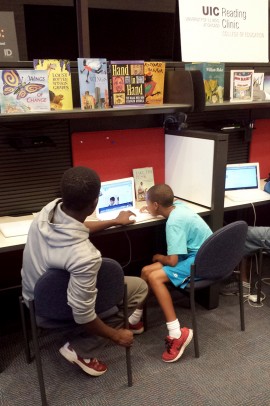Inspiring African American males to teach

“We need to reinvest in these boys,” says Alfred Tatum, professor of curriculum and instruction and interim dean of the College of Education.
Alfred Tatum is so committed to recruiting African American men to become teachers that he was willing to live in a campus residence hall for nine days last month, far from the comforts of home.
Tatum roomed with 21 high-achieving high school juniors and seniors who came from northern Illinois for the new Pre-College Leadership and Impact Program, held July 31 through Aug. 9.
Tatum, professor of curriculum and instruction and interim dean of the College of Education, hopes to inspire the teens to consider careers in teaching.
He was joined in the effort by doctoral student Marcus Croom and students in the college’s Youth Development master’s degree program.
“Our rate of enrollment of African American males in the College of Education is depressing,” Tatum said. “We need to reinvest in these boys.”
The instructors led their charges through 15-hour days of physical, intellectual and creative exercises, including two morning and evening one-mile runs each day.
“We always had a route that circled the College of Education. We sang cadence: ‘Tell me, tell me, what you see; I can see the COE.’ Every day I put another leader in front of the group,” Tatum said.
For five days, the high school students were trained in “five frames of leadership”: collaborative, cultural, community, youth and academic.
For the next five days, they were assigned to teach the same leadership exercises to 19 elementary school-age boys whose parents brought them to campus each day.
“The leadership interns are doing all the things the adults are doing,” Tatum said on the first day of the teens’ teaching. “They provided the orientation to the parents this morning. They’re exercising leadership.”
Not all of the high school boys were drawn to teaching, but this program could persuade them, Tatum said.
“When they work with elementary-age boys, I can convince them of the high impact they can have on boys who look like them,” he said.
The timing of funding for the program left Tatum with a 72-hour window for recruiting, yet he heard from more than 100 applicants from four states. He chose a mix of urban, suburban and small-town students.
Allan Lake, 16, a junior at the Chicago High School for Agricultural Sciences who is interested in teaching engineering, said he learned the importance of collaboration by attending the program.
He described the “helium stick” game, in which each teammate supports a yard-long dowel with one finger and all try to lower it to the floor while keeping it level.
“The hard thing is, when everyone at once is trying to get it settled, it gets higher,” Lake said.
“I’ve been torn between studying business and computer science in college,” said David Latimore II, a 15-year-old junior from Plainfield North High School. “But after I master the subject itself, I’d consider teaching it.”
Ty Jai, 17, a carpentry student at Manley Career Academy, found the mix of students enlightening.
“I’m a city kid from the West Side. I never thought I’d be close with a suburban kid, hanging out after the program, talking. I feel like I could teach a younger person a lot,” he said.
Croom said the teens showed two key qualities a teacher needs: “knowledge of your subject and how to connect with people; and a sense of who you are, so you’re culturally grounded and respectful of others.”
